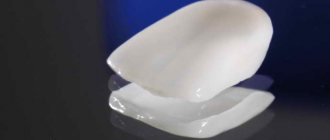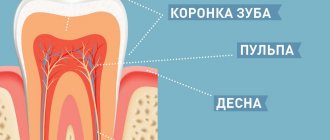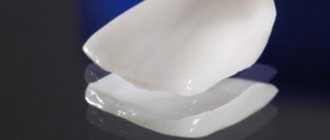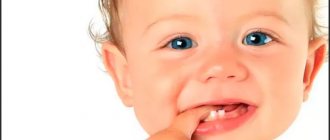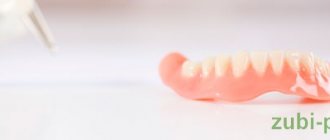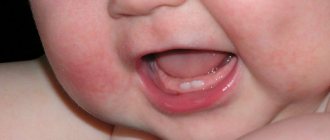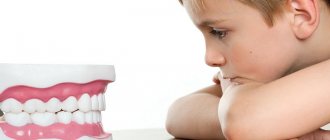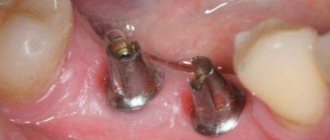Why is it important to maintain a milk bite?
If primary teeth are lost at 5-6 years of age, negative consequences often develop:
- The rudiments of permanent teeth developing in the gum lose their vector of movement and erupt outside the arch or even become impacted (lying in the bone).
- “Sixes”, the first permanent molars, erupt closer to the center of the jaw in place of the primary chewing teeth, leaving no room for the anterior group, causing crowding that requires long-term treatment with orthodontic appliances.
- Possible underdevelopment of the jaws due to lack of stimulation during chewing.
- In the absence of baby teeth, the jaws move closer to each other, the height of the bite is lowered, which affects the contours of the face.
- A child with early tooth decay is doomed to have difficulty chewing food and problems with the gastrointestinal tract.
- When a child loses teeth, his diction deteriorates.
All these troubles can be avoided by covering baby teeth with crowns.
Timing for replacement of primary teeth:
- central incisor - 6-7 years;
- lateral incisor - 7-8 years;
- fang - 10-11 years;
- first root - 9-10 years;
- the second radical changes to permanent only at 11-12 years of age.
It is very important to ensure that baby teeth last the entire specified period - until a permanent bite is formed.
Indications and contraindications
In childhood, crowns are needed in different situations:
- When a tooth is destroyed by caries more than half.
- With the so-called circular process, when superficial caries covers the entire perimeter of the cervical enamel zone.
- If, after treatment of pulpitis, the tooth is covered with a large filling, which is difficult to hold among the thin enamel walls that easily break off.
- In case of poor fixation of fillings, requiring their constant replacement.
- After a tooth injury with damage to its crown.
- If amelogenesis imperfecta is observed, it means underdevelopment of enamel.
- With Stainton-Capdepont syndrome - increased abrasion of hard tissues.
- Bruxism is teeth grinding, causing fillings to fail to stay in place.
- During orthodontic treatment, crowns are used as supporting elements.
Most children have direct indications for wearing crowns.
There are practically no contraindications to their manufacture, with the exception of a very rare intolerance to the materials from which the crowns are made.
There is no point in installing crowns on baby teeth when their roots have already undergone physiological resorption (absorbed) to half their length. This process begins two years before the baby tooth falls out.
In children, a simplified prosthetic technique is used, which allows one or several crowns to be installed in one visit, depending on the type of anesthesia.
Strip crowns
Modern pediatric dentistry is not limited to filling and removing damaged molars. To preserve the functionality of the dentition and form a correct bite, crowns are used on baby teeth. The children's dental clinic "Martinka" has created optimal conditions for comfortable and painless treatment. Innovative techniques and the use of modern materials make it possible to increase the effectiveness of treatment and preserve baby teeth until the formation of a permanent row.
Causes of decay of baby teeth
Primary molars are highly sensitive and prone to rapid development of caries. The disease is caused by a combination of factors, including:
- heredity,
- irregular oral hygiene,
- unbalanced diet,
- unfavorable environmental conditions.
Most parents are sure that the problem does not deserve attention, but this opinion is wrong. Premature loss of baby molars negatively affects the baby’s health. Scientifically based arguments convince us that healthy teeth form a correct bite and reduce the risk of developing diseases of the gastrointestinal tract and oral cavity.
Indications for installation of strip crowns
The creation of light-curing composite materials has led to the emergence of a perfect technique for restoring primary molars with strip crowns. This recovery method is used in the following cases:
- with deformation of primary incisors;
- abnormalities in the development of tooth enamel;
- injury to molars (for example, after a fall or blow);
- extensive carious process;
- grinding (bruxism);
- restoration of pulpless teeth.
Children's crowns are usually supplied in a set consisting of maxillary and mandibular celluloid copings of different sizes. The entire restoration process takes no more than 20 minutes and is an alternative to classic filling, silvering and removal.
Design advantages
For the restoration and reconstruction of primary teeth, strip crowns are an exceptional technology. Quick and painless installation of the structure allows you to preserve the molars until they are physiologically replaced, prevents the displacement of the dentition and forms the correct bite. The loads that a tooth covered with a temporary crown can withstand are greater than if it were restored with a filling. The undeniable advantages of children's strip crowns also include:
- precise restoration of the tooth shape, taking into account the individual characteristics of the bite;
- long-term protection of destroyed molars and reducing the risk of re-development of caries;
- no additional loads on the baby tooth;
- restoration of oral aesthetics and functionality of the dentition.
Stages of treatment
Treatment takes place under local anesthesia using standard technology: the diseased tooth is prepared, carious cavities are cleaned, and plaque is removed if necessary. The coronal part of the molar is shaped to ensure adhesion to the crown. Next, the prosthetic procedure begins.
- To determine the exact size, an acrylic blank is tried on.
- After fitting, the strip crown is cut to the required size, and its interior is filled with light-curing material.
- A cap filled with composite is placed on the prepared tooth, after which excess material is removed and the photopolymerization process begins.
- At the last stage, the crown is carefully removed, the composite material is re-fixed with a light lamp, and the restored molar is ground.
Despite the many stages, all manipulations are performed quickly and painlessly, so that the baby does not have time to get nervous.
Special Recommendations
Composite filling materials are used to create crowns on children's teeth, and care must be taken after the restoration procedure. That is why the technology is used to restore only the front milk teeth, which do not actively participate in the chewing process. You should follow the rules of hygiene procedures and avoid chewing loads on the front row of molars. To exclude recurrence of caries after 5–6 months, a re-examination by the attending physician is recommended.
Types of children's crowns
For children's prosthetics, ready-made sets of 16 crowns of different shapes and sizes are used for each jaw:
- Metal crowns made of steel or nickel-chrome alloy are used in the lateral sections of the dentition. They are not aesthetically pleasing, but they are durable and reliable in use.
- The American company NuSmile has been producing metal caps for temporary teeth with a white composite veneer for two decades.
- 3M ESPE DENTAL has created white composite crowns that provide psychological comfort to the child.
- Completely transparent acrylic protective Strip crowns are designed for front teeth.
- Protemp Crown light-cured composite crowns are designed to temporarily cover children's permanent teeth immediately after they have erupted if they have weak, incompletely formed enamel. They are aesthetically pleasing and reliably protect fragile hard tissues from the effects of external factors (saliva, temperature factors and irritating components of spicy food).
Popular brands of children's crowns
The range of children's crowns cannot be called wide. At the moment, the most widely used products are from two manufacturers:
- NuSmile – are highly aesthetic, durable, and hypoallergenic. Products of this brand are popular not only in pediatric dentistry, but also in adult dentistry. The structures are made of metal and covered with ceramics,
- 3M ESPE DENTAL - the company presents both crowns and caps (strip dentures). For production, the manufacturer uses special alloys that are biologically compatible with living tissue. In pediatric dentistry, nickel-chrome products are installed on the chewing group, and zirconium ceramics are installed on the anterior units of the dentition.
“When the child damaged his front teeth, I didn’t know whether it was possible to get crowns or whether they would have to be removed. It’s good that the doctor himself suggested it. White, smooth, like your own. Now the child is happy, and I am calm.”
Valentina R., from a review from babyblog.ru
Preparation and installation process
In order to strengthen crowns on teeth, a child does not need much patience:
- Teeth are cleaned of soft and hard plaque in advance.
- The dentist selects a crown of the desired size and shape and adjusts its height.
- The unpleasant procedure of taking impressions is not required.
- After local anesthesia (sometimes general anesthesia is used), the doctor treats the tooth, removing infected hard tissue and, if necessary, filling the root canals.
- Baby teeth are not ground down for a crown, preserving hard tissues, but only the chewing surface is removed by 0.3-0.5 mm so as not to increase the bite.
- The selected crown is fixed on the tooth with cement (if the crown is metal) or a composite material (strip cap).
The procedure for installing 1-2 crowns takes about 30 minutes.
Metal crowns for temporary teeth
Engel first talked about preformed metal crowns for temporary teeth in 1950, and with the help of Humphery, crowns gained popularity. Standard steel crowns for primary teeth are still used today. These crowns have many advantages, but one significant drawback is the lack of aesthetics. This makes metal crowns unsuitable for the restoration of anterior teeth. Manufacturers offered crowns with veneers for the anterior and posterior teeth, but the aesthetic requirements for primary teeth were constantly growing, which contributed to the creation of standard zirconium crowns for temporary teeth. Developments in this area continue, and many pediatric dentists are now creating custom aesthetic crowns.
Below we will talk in more detail about restoring damaged temporary teeth using standard metal crowns.
What are the positive qualities of standard metal crowns?
- Preserve severely damaged primary teeth until their physiological replacement.
- Maintain chewing function.
- They have a relatively low cost (compared to zirconium crowns).
- With a sufficient level of theoretical knowledge and practical skills, they are easily and simply recorded.
- Fixed in one visit.
- Antagonists do not harm.
- Correspond to the anatomical shape of the tooth.
- Contribute to the preservation of a sufficient volume of healthy hard tissues of a temporary tooth (the thickness of a standard metal crown is 0.2–0.3 mm).
When working with these crowns, novice pediatric dentists have many questions. I will try to highlight the most important, in my opinion, aspects:
- Determining the size of the crown before starting preparation. To do this, you can measure the mesiodistal size of the tooth in the oral cavity - manufacturers indicate the width for each crown size. Knowing the size of the tooth before preparation, you can easily select the size of the crown.
- Anesthesia. This stage is not always necessary, but most often it is necessary, because during the preparation of the tooth the gingival margin is inevitably injured.
- Isolation with a rubber dam is necessary if vital amputation or extirpation of the dental pulp is necessary before fixing the crown.
- It is better to start the preparation itself from the occlusal surface, the preparation depth is 1–1.5 mm.
- Preparation of proximal surfaces should be carried out from the mesial and distal surfaces. It is especially important to prepare the distal surface of the fifth teeth, since the absence or insufficient preparation of this surface can cause displacement of the crown at the time of eruption of the first permanent molar. The preparation of these surfaces must be gentle; damage to adjacent intact teeth is unacceptable!
- It is important that the crown is not too long. The edge of the crown should extend approximately 1 mm below the gingival margin. If the edge of the crown goes deep, then it is necessary to install the crown on the tooth, measure the gingival edge on the crown with a bur, remove the crown from the tooth and correct the length with special scissors. Afterwards, you need to carefully polish the edge of the crown.
- Cements for fixation can be: zinc phosphate, GIC, based on COE, glass ionomer, polymer modified.
- After fixing the crown, it is necessary to remove excess cement.
It is important to warn the child and parents about the occurrence of discomfort (painful sensations) in the area of the injured gum, explain that these sensations will decrease and complete healing will occur within a few days.
Advantages and disadvantages of children's crowns
Crowns have no disadvantages, except for the unaesthetic appearance of metal products.
But this method of protecting baby teeth has many advantages:
- Crowns reliably protect tissue from destruction, thereby maintaining the height of the bite and space for permanent teeth until the physiological change.
- Promote proper jaw growth - prevent the development of anomalies that subsequently require orthodontic treatment.
- Restore chewing function and aesthetics.
- Eliminates the need for constant re-treatment of teeth due to the fragility of fillings.
- Maintain clear diction.
- The method of prosthetics without grinding the enamel and taking impressions does not traumatize the child’s psyche.
When are crowns needed for temporary teeth and what are their advantages?
First of all, a crown for a child’s baby teeth is a reliable way to preserve temporary teeth until permanent teeth appear in the event of injury and destruction. Thanks to these products, the baby will be able to chew and talk normally. Baby teeth have fragile enamel and are very susceptible to infection, which means they have to be treated multiple times. To avoid this, it is easier to install a crown that will protect the tooth from further destruction. Indications for the use of these dental products are:
- tooth destruction by more than half;
- if the filling is too difficult to stay in the thin walls of the tooth;
- in case of injuries to the crown part of the tooth;
- the presence of enamel underdevelopment;
- increased abrasion of hard tissues;
- grinding teeth, etc.
Installing a metal crown on a baby tooth has virtually no contraindications. The only limitation is the child’s sensitivity to the materials used in the design. In our clinic we use only hypoallergenic crowns, which are completely safe for the health of children. Our experienced specialists are well versed in this issue and know exactly when it makes sense to install products.
By contacting Aesculapian dentistry on Kievskaya Street, you receive European care and the services of high-level doctors. We approach the treatment of each patient individually and always offer optimal solutions. We have the most modern diagnostic methods available, for example, computer tomography of children's teeth. This allows us to restore the oral health of children as effectively as possible.
Life time
After installing the protective caps, you need to visit the dentist once every six months to check the condition of the prosthesis and the tissues underneath it.
Children's crowns are in use for as long as a baby tooth lasts. As its root dissolves, they fall out along with the tooth, without causing unnecessary concern.
Cost of children's dental crowns
Installing one children's crown costs between 2.5-8.5 thousand rubles. The cost depends on:
- the material from which it is made;
- manufacturer;
- category of the clinic where prosthetics were performed.
Prices are current as of October 2020.
If you compare the cost of one crown with the costs of multiple visits to the doctor associated with installing fillings on the same tooth, with the waste of time and moral energy persuading the child, then many will agree that children's dentures are a beautiful solution to a difficult problem.
The main advantage of crowns is that they maintain the functional state and aesthetics of the dental system throughout the entire period of primary occlusion.
Author: Lidiya Vladimirova, dentist, especially for Karies.pro
Why put a crown on a baby tooth?
- preservation of the tooth until it is replaced;
- long-lasting and effective tooth protection;
- no pressure on the tooth itself.
It is very important to note that a crown is placed on baby teeth, as well as on permanent teeth, only after proper treatment, so that the tooth does not disturb the child in any way before it is replaced with a permanent one.
And one more thing - the procedure for prosthetics with a single crown in a child is simplified compared to that in adults. As a rule, the tooth is not ground down (because it is already quite damaged), impressions are not taken, and the crown is put on immediately after fitting. The fact is that there are ready-made sets of standard crowns for different groups of teeth, which the doctor only selects depending on the size of the tooth. The entire procedure for selecting and fixing the crown will take about 15–20 minutes. But the tooth will retain its chewing function, will not be destroyed, there will be no need to return to its retreatment, and it will fall out in accordance with the age-related changes along with the crown.
